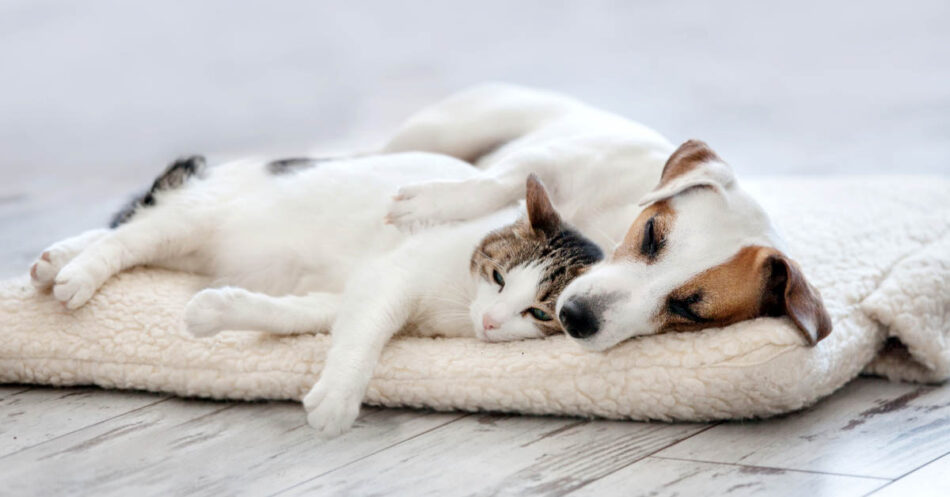
How to Keep Your Anxious Dog or Cat Calm While In The Car
This post may include affiliate links. Please read my disclosure policy.
Like many pet parents, I love having my fur family with me when I go places, whether it’s short car rides running errands or on longer road trips. But for some pets, just getting in a car sends them into an anxious spiral.
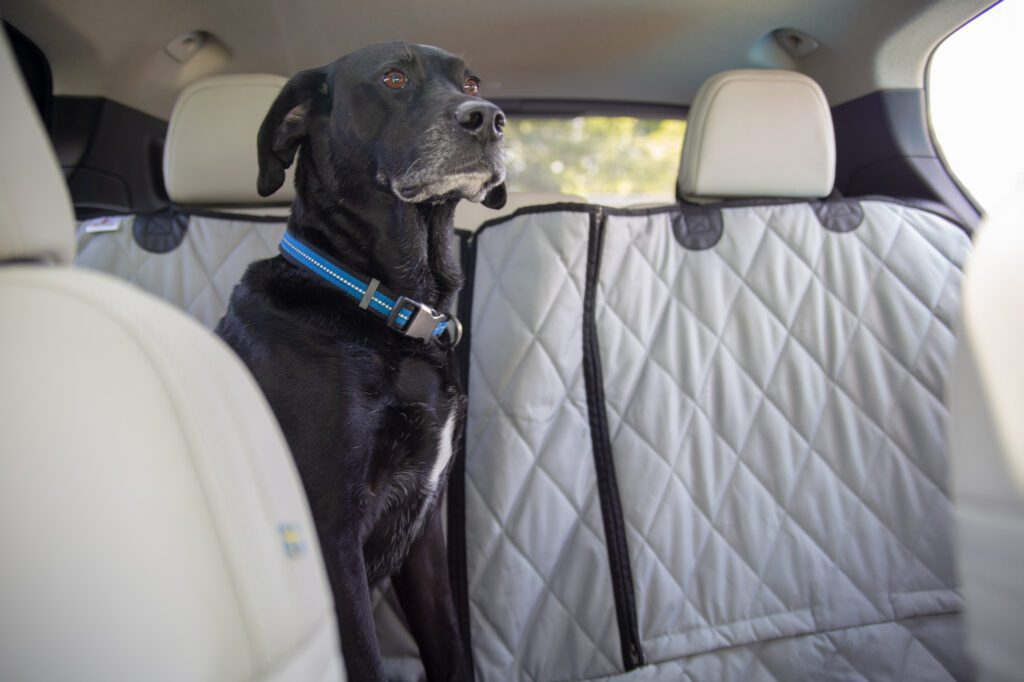
Thankfully, my dogs Chilly and Tulip don’t have any specific fears regarding traveling. But they do have other anxieties. Tulip suffers from separation anxiety, and Chilly has been diagnosed with noise aversion.
Since they have anxious tendencies, I like to be prepared with the right tools and products to ward off any anxiety surrounding car rides.
Plus, it seems like every dog and cat instinctively knows when they’re going to the veterinarian, which always causes anxiety!
Why It’s Important to Take Your Cat’s or Dog’s Anxiety during Travels Seriously
Have you ever been fearful, anxious, or stressed out? Many of us can relate to the heart-pounding, mind-racing effects of anxiety. Well, just as humans can suffer from anxiety, so can our pets. In fact, some pets experience the equivalent of a panic attack.
Now imagine feeling that way on every car ride. Then, add in all the stimulation from the constant movement, unpredictable road noise, and flashes of light. These stressful conditions can result in odd behavioral changes due to extreme anxiety in our fur friends.
Sadly, some pet parents don’t recognize the behavior as being rooted in anxiety, so they scold or discipline their pet. And at its worst, some may surrender their dog or cat to a shelter because they can’t manage the behavior and don’t know it’s rooted in fear.
That’s why it’s so important to know how to recognize the signs of car anxiety in our fur friends. And it’s also important to understand that the signs are different in cats and dogs.
Dog Car Anxiety Signs
Symptoms of car anxiety in dogs are varied and may include behaviors you haven’t thought of. Some symptoms may include:
- Barking or howling
- Chewing/destroying things
- Excessive licking
- Trying to escape
- Pacing
- Urinating
- Trembling
- Yawning
- Digging
Signs of travel anxiety may manifest differently. Many dogs feel anxious about getting in the car because they get car sick.
If you’ve ever had motion sickness, then you know how miserable it truly is. We wouldn’t want to endure that awful feeling, so of course, our dogs shouldn’t have to either. If your dog’s motion sickness is particularly bad, he might vomit on car rides, which can be painful and even more anxiety-inducing for your dog (and for you).
Here are other signs that your dog may have motion sickness:
- Drooling
- Dry heaving
- Excessive lip licking
- Excessive panting
- Inactivity
- Pacing
- Restlessness
- Shaking
- Vomiting
- Whining
- Yawning
- Bracing stance
You’ll notice many of the signs of motion sickness and car anxiety overlap. So it’s important to visit your veterinarian to determine the true cause of your dog’s abnormal behavior while in the car.
A few years ago, I noticed some of these signs in my dog, Chilly. After consulting with our veterinarian, he prescribed a medication that doesn’t make your pup drowsy or loopy. To learn more, check out my blog post here.
How to Help Dogs with Car Anxiety: Dos and Don’ts
Aside from getting help from a veterinarian, there are simple ways you can help your pup enjoy a car ride a little more. Here are some dos and don’ts to take note of if your dog is suffering from motion sickness and even car anxiety:
Dos
- Begin slowly. Introduce your dog to the car in a non-threatening way—this is an incredibly important step, especially if you intend to change your dog’s previously bad association with cars. Start by rewarding them for simply approaching the car, being near a car door, then gradually have them spend time inside with the car parked.
- Use positive reinforcement. Always use praise and treats to create positive associations with the car. Never scold or punish your dog when they show signs of being afraid.
- Bring your pup’s familiar items. Placing your dog’s favorite toys or a blanket in the car to help them feel like the car’s safe, like their home, may help with car sickness.
- Help them with their motion sickness. If you’ve ever been sick while on the road, you’ll know it’s quite a miserable experience. This is the same for our pooches. If your dog does get car sick, limit food and water before trips and keep the car cool. If your dog still has motion sickness even when they’ve overcome their car anxiety, maybe it would be best to leave them at home during family trips.
- Do consistent short drives. Start with very short drives, like to the end of the driveway, and slowly increase the distance as your dog becomes more comfortable.
- Exercise beforehand. A good play session before a car ride can help with dog anxiety.
- Remember, safety first. Always secure your dog with a crate, harness, or seatbelt designed for car use. You also wouldn’t want your pup to be super active in a moving vehicle—it might cause a car accident!
Don’ts
- Rush the process. Avoid forcing your dog to face its fears too quickly. This can increase travel anxiety rather than alleviate it.
- Neglect signs of distress. If your dog seemingly gets worse at handling car rides, they may have dog car anxiety. Persistently taking them to more car rides can lead to frequent motion sickness, which makes the experience even more distressing and miserable for your pup. Take a step back in your training.
- Only drive to negative destinations. Avoid associating car rides solely with trips to places like the veterinarian. This may trigger or make symptoms of dog anxiety even worse. Mix in their favorite places or fun destinations like a dog park or familiar trails.
Cat Car Anxiety Signs
Unfortunately, cat car anxiety is much less likely to be diagnosed or recognized than anxiety in dogs. Our furry feline friends tend to be more mysterious in everything they do. So it’s especially important to be on the lookout for the subtle signs of cat anxiety.
Symptoms of car-related anxiety frequently include:
- Hiding
- Not eating
- Social withdrawal
- Panting
- Dilated pupils
- Aggression
- Twitching tails or ears
- Failure to use the litter box
- Clinginess
- Pacing
- Hair loss from excessive grooming
- Increased vocalization
- Becoming less active
Have you noticed any of these signs of anxiety in your kitty? With a keen eye and a little planning, you can be alert to the signs of anxiety in your cat and take the best steps to keep her calm and cozy while she’s in the car.
How to Help Cats with Car Anxiety: Dos and Don’ts
A colleague’s cat, Plip, used to yowl at the top of his lungs during car trips to his veterinarian. This is a very clear indication of his anxiety, but remember, other cats may not be as vocal. Regardless, let’s run over some good dos and don’ts to keep in mind for our kitties’ comfort:
Dos
- Familiarize your cat with the carrier. Introduce your cat to the carrier well before the trip. Let them explore and get comfortable with it in a familiar environment. Placing treats or their favorite bedding inside can help create positive associations.
- Keep your cat in sight. On trips, place the carrier where your cat can see you, as your presence can be reassuring.
- Talk and play calm music. A gentle voice can soothe your cat. Playing calming music or cat-specific playlists can also help drown out unsettling car noises.
- Have some pre-trip playtime. Tire your cat out before the trip with playtime. This can help them sleep through the ride, reducing stress.
- Kee your car at a comfortable temperature. Ensure the car is at a comfortable temperature and well-ventilated.
- Drive smoothly. Avoid sudden stops and sharp turns to make the ride smoother for your cat.
Don’ts
- Do sudden introductions. Don’t introduce your cat to the carrier or car suddenly. Gradual introduction is key to building trust and comfort.
- Do loud noises. Keep the car environment as quiet and calm as possible. Loud music or yelling can increase anxiety.
- Rush the process. Take your time with each step of getting your cat accustomed to car travel. Rushing can backfire and increase their anxiety.
Pin me!
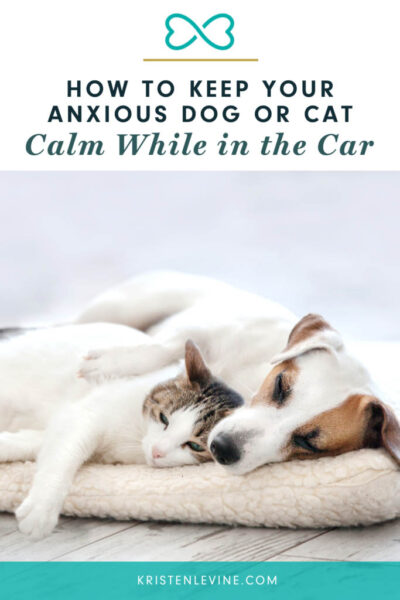
How ThunderShirt Can Help Your Dog or Cat on Car Rides
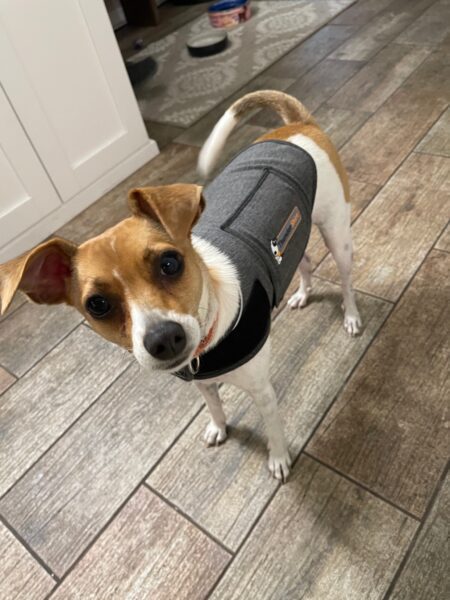
Another thing you can do to help alleviate cat or dog car anxiety symptoms is to have your pets wear something that’s similar to warm (your) hugs! ThunderShirt is a must-have in the Levine household. It’s veterinarian-recommended and proven to be over 80% effective in calming pets during anxiety-inducing events, such as travel and drives to the vet. ThunderShirt has helped millions of dogs and cats (pet parents) regain peace and calm. I personally use it to keep my dogs, Chilly and Tulip, calm on short car rides, especially when we go to the vet.
Just like swaddling an infant, ThunderShirt is designed to apply gentle, constant pressure to your dog or cat’s torso.
Researchers suggest that this type of pressure can release calming hormones like oxytocin or endorphins in both humans and animals. Think about how you feel when you get a warm hug from a loved one! This gentle pressure is helpful for calming all types of anxiety and fear.
Note: ThunderShirt works great for cases of mild to moderate anxiety. But if your pet is showing signs of severe anxiety, please consult your veterinarian, as they may require prescription medication.
Other Helpful Therapies to Ease Cat or Dog Car Anxiety
ThunderWunders is another effective natural solution that can ease your cat or dog’s anxiety. These calming chews are vet atrainer-recommendedded, with options for both adult dogs and cats.
They contain ingredients that promote rest and relaxation. And they’re packed with calming agents like Thiamine, L-Tryptophan, and Melatonin to help your pet remain calm in stressful situations.
Plus, their cat chews have even been feline taste-test approved. So even if your cat is a picky eater, she’s likely to enjoy the flavor. ThunderWunders chews are a great solution for car rides, trips to the vet, or meeting new pets and new people.
I’m also a big fan of ThunderEase Calming Collar for Dogs. This unique collar is drug-free, easy to use, and over 90% effective. It works by releasing natural pheromones that mimic the pheromones a nursing mother releases for her pups, leaving them feeling calm and protected.
The calming collar is activated by your dog’s own body heat and helps him feel safe and serene just like when he was a nursing puppy.
I’ve used the calming collar on my dogs, and it works wonders at helping them adjust to challenging situations and curbing unwanted stress-related behaviors.
ThunderEase Cat Calming Pheromone Spray is great for when you’re on the go! You can spray the calming pheromones directly onto objects such as your car, your kitty’s carrier, or her favorite blanket. The spray will mimic her mother’s natural nursing pheromones, putting her at ease and reducing unwanted behaviors. Car rides and visits to the vet will be much calmer.
Even with the best preparation, your pup or kitty may still be a little anxious once you arrive at your final destination. If so, then ThunderEase Diffuser for dogs or cats will help.
Each kit vet-recommendedded and clinically tested to be effective for 90% of dogs and cats, respectively.
Simply plug into an outlet in the room where your dog or cat spends most of their time. The diffuser releases a drug-free, odorless vapor that can cover up to 700 square feet and last up to 30 days. As your dog or cat is reminded of their mother’s love, their stress will fade away. And so will some of the troubling behavior issues that are common in anxious dogs and cats. I use the diffuser in my house to help my cat, Olivia, when she’s feeling stressed or skittish.
Can Your Pet’s Travel Anxiety Be Cured?
The short answer is maybe. Most of the time, with the right therapies, a dog or cat’s anxiety can be greatly improved so that it’s almost imperceptible. But it’s important to talk to your veterinarian about your pet’s anxious behavior because there may be medical reasons that need to be addressed. And some cases of strong anxiety warrant prescription anti-anxiety medication.
But with expert help, a variety of calming solutions, and unconditional love from their pet parents, our fur families can have less stress and live happy, healthy lives.









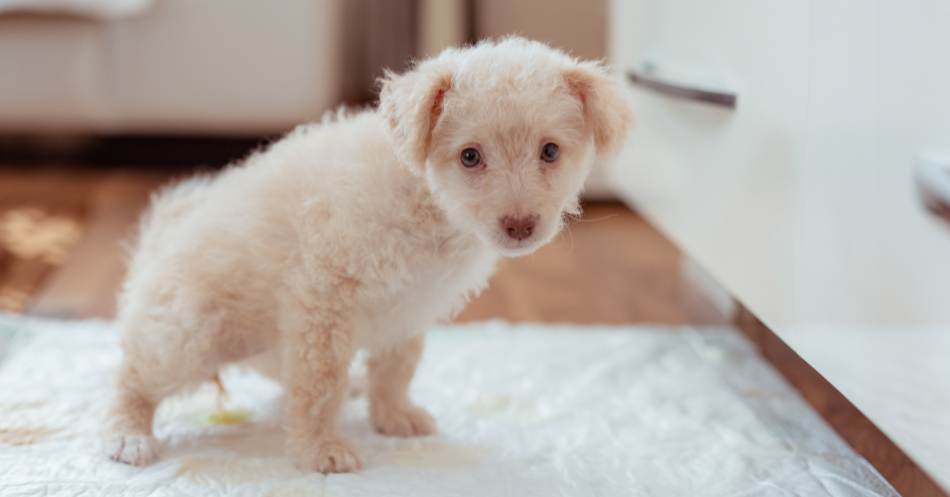
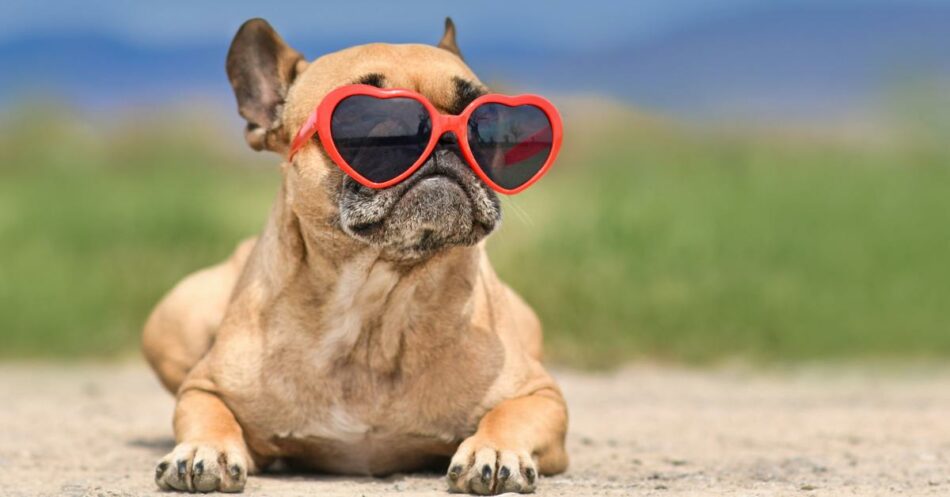
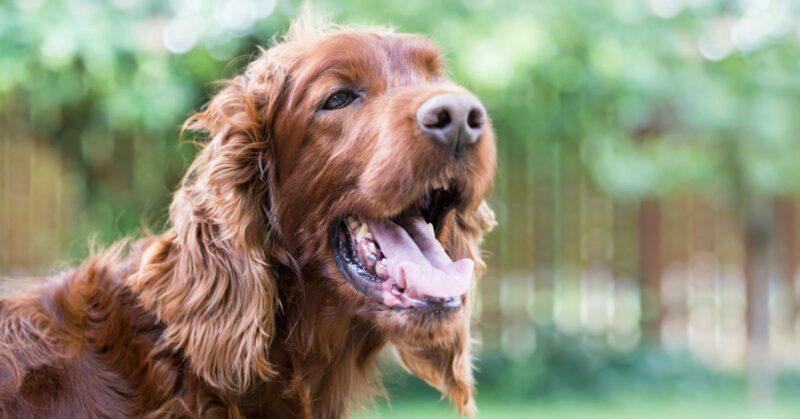
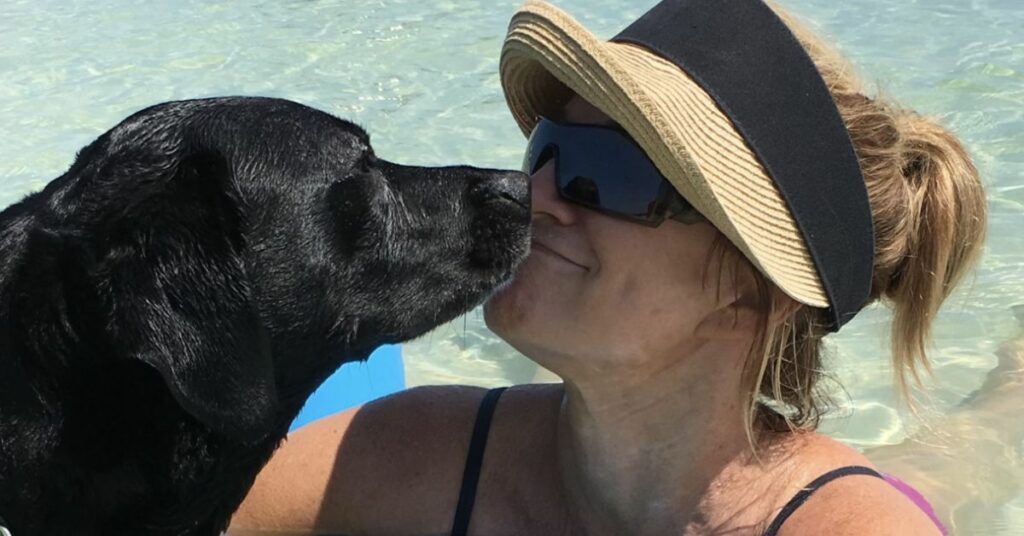
Good information..Thank you
Absolutely fantastic ideas for relieving anxiety in my rescues. Triscuit, especially, has storm anxiety & tries to hide in places WAY smaller than her. I feel so bad for her & have tried different techniques. I think it’s finally time to give your products a try. Both Triscuit and Cocoa deserve to feel safer than what I alone have tried. (And the whole family can use some rest). Love to win a Thundershirt in the giveaway.
Michelle,
Anxiety is so common in dogs, and it can be so heartbreaking to see them suffer! Helping anxious pups and their pet parents is something that’s near and dear to my heart, so I’ve written many posts on this site about helpful tips and techniques (here’s a list of all of them). I hope you find something that works for Triscuit and Cocoa – it sounds like they were very fortunate to be rescued by a loving and supportive family!
Wags,
Kristen
Thunder shirts do not work for my German Shepherd unfortunately.
Thanks for all the information it’s very useful